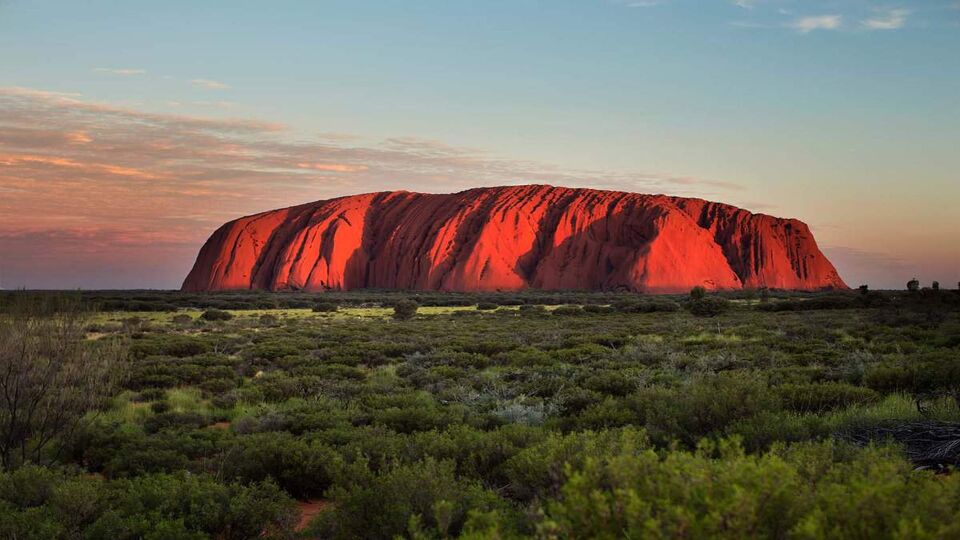Alice Springs
Price A$367
Min age 3
Rating 4.56 / 5 [604 ratings]
Tour supplied by:
Bucket list destination:
Uluru-Kata Tjuta National Park, Northern Territory, Australia

Uluru, the world’s largest rock monolith, is synonymous with Outback Australia. Alongside the Sydney Opera House, it is perhaps Australia’s most iconic sight.
But The Rock is at the centre of a living cultural landscape known as the Uluru-Kata Tjuta National Park, a vast area of desert containing several other major draws – the domes of Kata Tjuta, Walpa Gorge and The Valley of the Winds. A few hours away, in neighbouring Watarrka National Park, is another extraordinary natural phenomenon – Kings Canyon.
It’s the place to come to experience the Australian outback, Crocodile Dundee-style. As well as admiring the jaw-dropping geology, you can sleep out in swag bags, sample bush tucker, dine under a billion stars and spot kangaroos.
Now under the control of its traditional owners – the ‘Anangu’ – the park offers a unique opportunity to experience and learn about the planet’s oldest living culture – the indigenous Aboriginal people. The local Anangu people offer a variety of excellent tours and activities – from guided walks to didgeridoo lessons and dot painting workshops.
All of the tourism facilities for the park are concentrated in the township of Yulara, situated outside Uluru-Kata Tjuta National Park, about a ten-minute drive from the entry station. This is you base for trips to Uluru, Kata Tjuta and Kings Canyon.
Most of the Yulara township is made up of the ‘Ayers Rock Resort’, an Aboriginal-owned complex that provides accommodation, restaurants and other essential services to people visiting the park. The resort is a one-stop shop for pretty much all of the organised tours and activities in the area.
Yulara is a settlement consisting of a few low-slung, modern buildings, a few gum trees and plenty of red dirt. While busy, Yulara is rarely crowded – it’s a different story at Uluru where the carpark is packed with campervans, coaches and hire cars.
The focal point of Yulara is the Ayers Rock Resort Town Square, a modest collection of cafes, shops and art galleries.
Most of the accommodation in Yulara is within easy walking distance of the square but a free bus service also operates – handy if want to avoid the desert sun.
Our selection of the best Viator tours of this destination, plus helpful tickets and transfers
Alice Springs
Price A$367
Min age 3
Rating 4.56 / 5 [604 ratings]
Tour supplied by:
Uluru
Price A$249
Min age 0
Rating 4.56 / 5 [155 ratings]
Tour supplied by:
Alice Springs
Price A$995
Min age 8
Rating 4.87 / 5 [124 ratings]
Tour supplied by:
Alice Springs
Price A$254
Min age 2
Rating 4.58 / 5 [34 ratings]
Tour supplied by:
Winter (June to August) is the ideal time to be in the desert. This is also the busiest time of the year, when accommodation is at a premium, so spring and autumn can work well too.
Desert summers (December to March) are notoriously hot and not suitable for much physical activity. It’s also the wet season, when getting around can be difficult. Summer is when the air is filled with relentless swarms of annoying flies (though you can buy the classic hat with accompanying fly net to keep them off your face). On the plus side, it’s less crowded and rainfall over Uluru is spectacular.
There are daily flights to Uluru from Sydney, Melbourne and Brisbane, with direct flights also available from Adelaide and Cairns. Those with plenty of time on their hands can book a cabin on The Ghan, a transcontinental railway from Adelaide to Darwin, and take a side trip from Alice Springs to Uluru and Kata Tjuta.
Hotel guests arriving at Ayers Rock Airport will find a free shuttle to take them to their accommodation. All of the accommodation in Uluru is clustered around the Ayers Rock Resort town square. In the cooler months it’s easy to walk around the resort but if you want to avoid the desert heat jump aboard the free bus – it operates all year round, with departures every 20 minutes.
Since this is a desert region with no trains or bus routes, visitors will need to hire their own vehicle or join an organised tour to access the surrounding experiences.